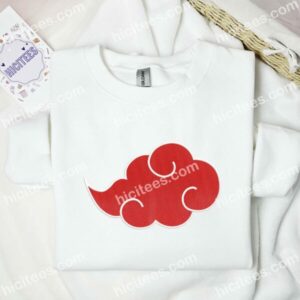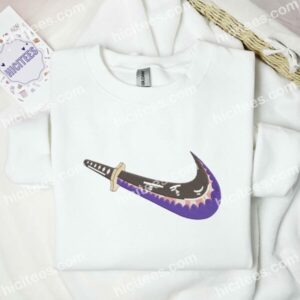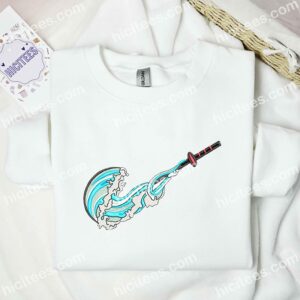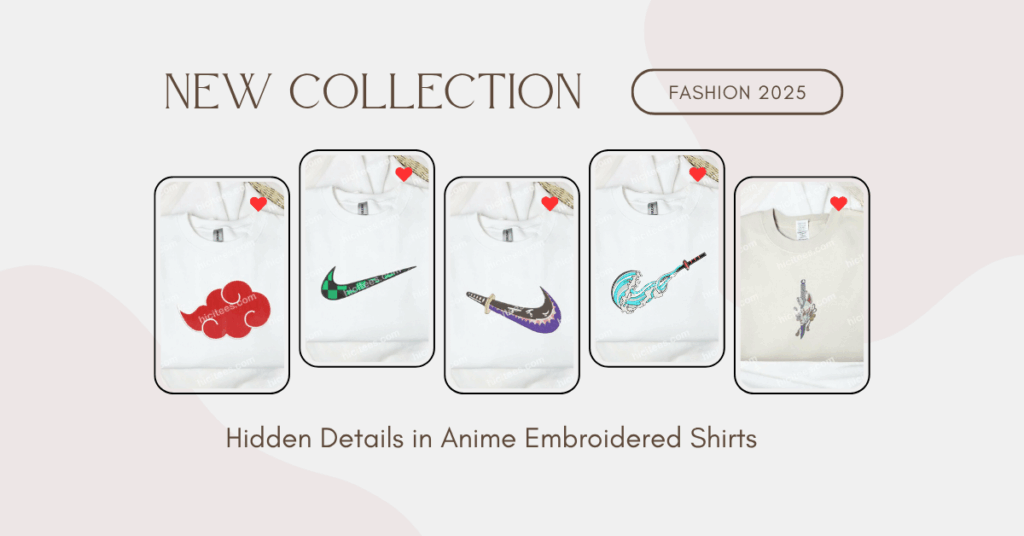News
5 Hidden Details in Anime Embroidered Shirts That Only True Fans Will Notice
Anime embroidered shirts are more than just a fashion trend—they’re a celebration of fandom, personality, and storytelling.
To the casual eye, these shirts might just look like cool designs of popular characters or symbols.
But to a true anime fan, they are full of subtle nods, hidden meanings, and insider references that speak volumes.
These tiny details aren’t always front and center. In fact, many of the most powerful elements are tucked away in the corners of sleeves, hidden in folds, or stylized just enough to blend in—like an Easter egg meant only for those who know.
This blog will take you deep into the world of these often-overlooked details.
From clan symbols to signature weapons, from magical effects to emotionally charged patterns, we’re diving into five types of hidden elements that make anime embroidered shirts a treasure trove of references.
Whether you’re designing your own shirt, looking to buy something with meaning, or simply curious about what separates casual fanwear from a true collector’s piece, this is your guide to the hidden art of anime embroidery.
Clan Symbols and Family Crests
One of the most common hidden details in anime embroidered shirts—especially in shonen series—is the use of clan symbols or family crests.
These tiny insignias might be stitched subtly onto the collar, sleeve, or even near the hemline of a shirt. They’re not flashy, but they carry deep meaning.
Take the Uchiha clan from Naruto, for example. Their red-and-white fan symbol doesn’t need an introduction among Naruto fans.
When it appears subtly embroidered onto the sleeve of a black shirt, it instantly evokes thoughts of Itachi, Sasuke, and the tragic history of the clan.

Similarly, the Hyuga clan’s swirling flame crest can be embroidered in soft gray or white thread, barely noticeable from afar, but instantly recognizable to anyone who knows Hinata or Neji.
In Attack on Titan, fans often spot the Scout Regiment’s Wings of Freedom, but even deeper references like the Reiss family crest or Marleyan military badges can be added to a shirt for a true fan touch.
These details are perfect for subtle, sophisticated designs that don’t scream anime to the outside world but speak volumes to insiders.
Even series like Demon Slayer offer unique hidden detail opportunities. Tanjiro’s checkered haori pattern and the Rengoku family flame symbol are prime examples.
By placing these designs on the inside hem or back neck area, the shirt becomes a personal badge of allegiance to the character’s lineage and story arc.
Signature Weapons and Iconic Gear
True anime fans don’t just love the characters—they love the gear that defines them.
Signature weapons are not only recognizable but emotionally connected to major story moments, arcs, and fights.
When these weapons are embroidered in subtle, clean outlines—perhaps tucked into the background of a design—they transform a shirt into a secret storytelling canvas.
Let’s take Bleach as an example. Ichigo’s Zangetsu sword, with its distinct, oversized, cleaver-like appearance, can be embroidered in silhouette behind his character.
Some shirts don’t show Ichigo at all—just the sword—and still, true fans recognize it instantly.
Or consider Demon Slayer, where each character has a uniquely colored Nichirin blade.
Stitching Tanjiro’s black katana with its fiery red lettering or Inosuke’s jagged dual swords onto a shoulder or sleeve turns a design into a hidden reference masterpiece.
In One Piece, Zoro’s three swords—Wado Ichimonji, Sandai Kitetsu, and Enma—are more than just tools. They’re a reflection of his values, battles, and past.
Embroidering all three in a crisscrossed bundle or just placing the hilt of Enma at the side seam of a shirt can hint at deep knowledge of Wano and Zoro’s journey.

Even in Jujutsu Kaisen, details like Gojo’s Infinity technique can be paired with the outline of his blindfold and Blue/Red curse orbs for fans who understand the mechanics of his power.
When weapons or gear are included in embroidery, they’re often scaled down and placed near the cuffs or along seams—making them a fun discovery when noticed.
Hidden Magic Effects and Elemental Motifs
Anime isn’t just about the characters and what they carry—it’s about how they fight, what they represent, and the magic or elemental themes they use.
One clever trend in anime embroidered shirts is the use of hidden magical or elemental patterns to add depth to a design.
These aren’t always literal—they may appear as swirling wind, crackling lightning, or blooming fire—but they’re often visual cues tied to specific powers or characters.
Take My Hero Academia. Embroidering Katsuki Bakugo’s explosion effect using orange and yellow burst motifs is a smart way to suggest his quirk without ever stitching his face.
Todoroki’s ice and fire can be shown as a split colorwave moving diagonally across the garment—cold blue on one side, red-hot flames on the other.
In Demon Slayer, characters are deeply linked to breathing styles that generate stylized visual effects.
Water Breathing’s flowing waves, Thunder Breathing’s lightning bolts, or Flame Breathing’s curling flames can be delicately embroidered into the fabric behind a logo or scattered near a character’s sleeve.

One subtle example is embroidering Naruto’s Rasengan swirl behind his silhouette or along the back of a hoodie.
Fans who recognize the symbol know it’s more than just a spiral—it’s a reference to Minato, Jiraiya, and Naruto’s heritage of power.
Even Fullmetal Alchemist’s transmutation circles are often stitched in pale thread along pockets or inner seams, adding philosophical depth to an otherwise casual design.
These embroidered magic effects are like a second language—a visual whisper that only fans fluent in the anime’s world can understand.
Emotional Icons and Symbolic Motifs
Beyond weapons and powers, anime is full of powerful symbolism—small visual motifs that carry deep emotional weight.
True anime embroidered shirt designs take advantage of these tiny elements to add subtle layers of meaning to their pieces.
One standout example comes from Tokyo Ghoul, where Kaneki’s mask is often represented in a minimal form—just the single eye, the teeth line, or the chain.
Fans know that this isn’t just an accessory. It’s a symbol of Kaneki’s dual identity, his trauma, and his transformation.
When that mask is embroidered into the inside lining of a hoodie or the back of a collar, it becomes a quiet statement of pain, survival, and evolution.
In Violet Evergarden, something as simple as a letter or mechanical hand embroidered on a shirt can bring fans to tears. It represents connection, the unsaid, and the journey of healing.
These kinds of designs often focus on story-driven items rather than flashy action.
Spirited Away offers plenty of examples: the embroidered train tickets, bath tokens, or No-Face’s mask are gentle nods to the emotional layers in Miyazaki’s storytelling.
Embroidering these into a pocket or chest corner lets wearers carry a sense of nostalgia and emotional connection.
Even food can become an emotional symbol. The bento box in Fruits Basket, onigiri from Clannad, or Ramen from Naruto aren’t just meals—they’re threads of comfort, friendship, or family.
When embroidered subtly into the bottom hem or a sleeve, they resonate deeply with those who understand their significance.
Insider Text, Kanji, and Hidden Phrases
One of the most brilliant ways designers add hidden value to anime embroidered shirts is through kanji, hiragana, and cryptic quotes.
These words often look beautiful even to those who can’t read Japanese, but for fluent fans, they hold inside jokes, references, and sometimes heartbreaking meanings.
The kanji for “justice” (正義) might be stitched in red on a plain white shirt—but only real fans will know it references Luffy’s Marine opponents, or maybe Death Note’s conflict between Light and L.
Similarly, small text like “Nakama” (仲間) means “crew” or “companions,” and when placed near the hemline, it becomes a quiet One Piece homage.
Quotes are another opportunity. Short lines like “I want to protect them all” (from Jujutsu Kaisen), or “Even if I can’t forgive myself… I’ll keep moving forward” (Attack on Titan) are sometimes embroidered in small cursive script on the inside collar, or written in katakana on the back of a sleeve.
These details create intimacy. The wearer knows what the quote means, but it’s not something that screams anime. It whispers it.
Some shirts go even further and embed reverse kanji, character monologues, or even author easter eggs in hidden places like the side seam or inside label.
It’s the ultimate tribute for the diehard fan—a message meant only for those who truly pay attention.
Final Thoughts: For the True Fans Who See What Others Don’t
In the end, anime embroidered shirts are full of storytelling potential.
They can be loud or quiet, bold or whisper-soft, but the best ones are built with layers.
Hidden clan symbols, signature weapons, magical motifs, emotional icons, and insider kanji make each piece something more than just fashion.
They become threads of identity—each stitch a nod to the stories we love and the characters who’ve shaped us.
So the next time you look at an anime shirt, take a second look.
Check the cuffs. Read the back of the neck. Peer into the folds. You might just find a secret detail that speaks directly to your fan heart.
And if you’re designing your own anime embroidery? Don’t just think about who you want to show off.
Think about what you want to hide—for those who know, those who feel, and those who see what others don’t.
Happy stitching—and happy spotting.


